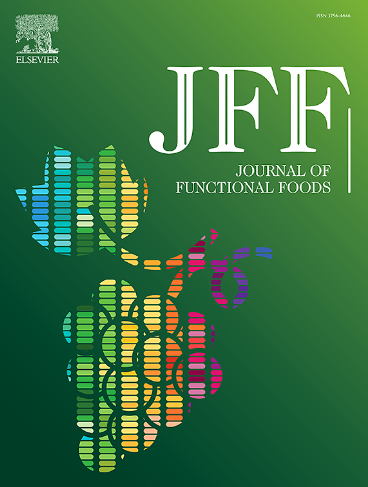High-dose supplementation of Chlorella and Spirulina increases beneficial gut Bacteria in healthy ICR mice: A 90-day feeding study
IF 3.8
2区 农林科学
Q2 FOOD SCIENCE & TECHNOLOGY
引用次数: 0
Abstract
Microalgae are increasingly recognized as important protein sources, and their potential probiotic functions have recently gained attention. This study investigated the effects of microalgae biomass (ChB from Chlorella pyrenoidosa and SpB from Spirulina platensis) on the gut microbiota of healthy ICR mice following a 90-day feeding experiment. Various health indicators were monitored to assess the health status of animals. Oral administration of ChB and SpB at doses of 0.82 g/kg and 4.10 g/kg did not result in any treatment-related impairment of physical indicators in mice. High-throughput sequencing of fecal 16S rRNA revealed that the mice receiving high-dose ChB and SpB supplementation showed increased abundance of beneficial bacteria, particularly Lactobacillaceae and Muribaculaceae, and decreased abundance of unfavorable bacteria, notably Erysipelotrichaceae and Staphylococcaceae. The ChB-H and SpB-H groups formed clusters that were distinctly separated from the control group based on PCoA analysis, although the α-diversity was not statistically significant. PICRUSt functional analysis revealed that high-dose treatments with ChB and SpB significantly altered pathways related to lipid and amino acid-related metabolism. A strong association was observed between the pathways and microbial families. These results suggest potential health effects mediated by gut microbiota modulation. The diversity and composition of gut microbiota in the low-dose groups were comparable to those in the control group. In summary, high-dose supplementation of ChB and SpB resulted in enhanced levels of beneficial bacteria in the mice gut, which may contribute to physiological changes in the host. Therefore, ChB and SpB could serve as prebiotics to promote health.

高剂量补充小球藻和螺旋藻可增加健康ICR小鼠肠道有益菌群:一项为期90天的喂养研究
微藻作为一种重要的蛋白质来源越来越受到人们的重视,其潜在的益生菌功能近年来受到人们的关注。本研究通过90 d的饲养试验,研究了微藻生物量(pyrenoidosa小球藻ChB和螺旋藻SpB)对健康ICR小鼠肠道微生物群的影响。监测各种健康指标,以评估动物的健康状况。口服剂量分别为0.82 g/kg和4.10 g/kg的ChB和SpB对小鼠的身体指标没有造成任何与治疗相关的损伤。高通量粪便16S rRNA测序显示,高剂量ChB和SpB补充小鼠的有益菌丰度增加,特别是乳酸杆菌科和Muribaculaceae,而不利菌丰度降低,特别是丹毒和葡萄球菌科。根据PCoA分析,ChB-H和SpB-H组与对照组明显分离,但α-多样性无统计学意义。PICRUSt功能分析显示,大剂量ChB和SpB治疗显著改变了脂质和氨基酸相关代谢的相关途径。在这些途径和微生物家族之间观察到强烈的关联。这些结果表明,肠道菌群调节介导了潜在的健康影响。低剂量组肠道菌群的多样性和组成与对照组相当。综上所述,大剂量补充ChB和SpB可提高小鼠肠道有益菌的水平,这可能有助于宿主的生理变化。因此,ChB和SpB可作为促进健康的益生元。
本文章由计算机程序翻译,如有差异,请以英文原文为准。
求助全文
约1分钟内获得全文
求助全文
来源期刊

Journal of Functional Foods
FOOD SCIENCE & TECHNOLOGY-
CiteScore
9.60
自引率
1.80%
发文量
428
审稿时长
76 days
期刊介绍:
Journal of Functional Foods continues with the same aims and scope, editorial team, submission system and rigorous peer review. We give authors the possibility to publish their top-quality papers in a well-established leading journal in the food and nutrition fields. The Journal will keep its rigorous criteria to screen high impact research addressing relevant scientific topics and performed by sound methodologies.
The Journal of Functional Foods aims to bring together the results of fundamental and applied research into healthy foods and biologically active food ingredients.
The Journal is centered in the specific area at the boundaries among food technology, nutrition and health welcoming papers having a good interdisciplinary approach. The Journal will cover the fields of plant bioactives; dietary fibre, probiotics; functional lipids; bioactive peptides; vitamins, minerals and botanicals and other dietary supplements. Nutritional and technological aspects related to the development of functional foods and beverages are of core interest to the journal. Experimental works dealing with food digestion, bioavailability of food bioactives and on the mechanisms by which foods and their components are able to modulate physiological parameters connected with disease prevention are of particular interest as well as those dealing with personalized nutrition and nutritional needs in pathological subjects.
 求助内容:
求助内容: 应助结果提醒方式:
应助结果提醒方式:


